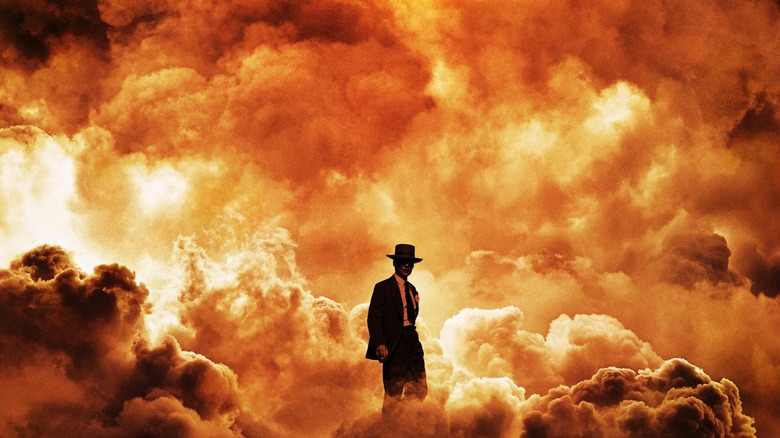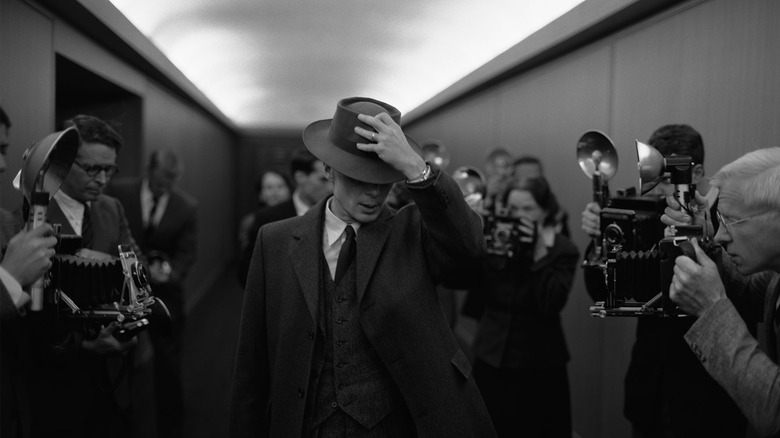Christopher Nolan's Biggest Challenge On Oppenheimer Was Creating A Nuclear Detonation With No CGI
Not to start everybody's Monday off on the worst possible note, but I have prepared a theoretical math equation for the class. The unstoppable force of Hollywood's most practical effects-obsessed filmmaker meets the immovable object of history's most infamous, horrific, and certainly not very film-friendly subject matter. Who wins? Well, that would be one Christopher Edward Nolan, of course, in case you had any actual doubt.
What else would one expect from the visionary filmmaker? Need we remind you, the man had his special effects team build full-scale and fully-drivable models of the tank-like Tumbler for his "The Dark Knight" trilogy, perfected that nifty rig set up on gimbals to simulate the revolving hallway set piece in "Inception," crashed a World War II-era replica aircraft into the sea for "Dunkirk," and actually created a black hole for "Interstellar" before inventing time travel to bring us those temporal pincer movements in "Tenet." (Okay, fine, those last two bits may or may not be a lie.)
In any case, in the perpetual battle between practical effects and state-of-the-art visual effects — let it be known that Nolan has utilized plenty of both during his career, easy narratives aside — has found itself a whole new champion in the form of Nolan's latest, "Oppenheimer." Centered on the life of the real-life mastermind behind the Manhattan Project, J. Robert Oppenheimer (Cillian Murphy), the upcoming biopic is set to deliver on the filmmaker's usual strengths. That means we can expect plenty of adult-minded drama, jaw-dropping visuals, and maybe a dead wife or two. But if Nolan is to be believed, it would appear he found a way to depict a nuclear explosion ... without the use of CGI. Because of course he did.
'There were huge practical challenges'
It takes a certain kind of confidence to look at the historical events of the United States dropping two atomic warheads on Japan to bring World War II to a hellish end and craft an entire movie about the profoundly regretful scientist who was ultimately responsible for the creation of those weapons in the first place. It takes a whole other kind of mindset to pitch that story and then go about filming what will undoubtedly be the biggest, most terrifyingly spectacular visual of them all with the use of practical effects.
Apparently, that's exactly what Christopher Nolan claims to have done with "Oppenheimer." In an interview with Total Film, the writer/director remained fully on-brand as he talked up the hard work involved in staging nuclear explosions without the use of CGI. As he put it:
"I think recreating the Trinity test [the first nuclear weapon detonation, in New Mexico] without the use of computer graphics, was a huge challenge to take on. Andrew Jackson –- my visual effects supervisor, I got him on board early on –- was looking at how we could do a lot of the visual elements of the film practically, from representing quantum dynamics and quantum physics to the Trinity test itself, to recreating, with my team, Los Alamos up on a mesa in New Mexico in extraordinary weather, a lot of which was needed for the film, in terms of the very harsh conditions out there -– there were huge practical challenges."
Yeah, you could say that again. Referring to the movie overall as "one of the most challenging projects I've ever taken on," the exact methods of how he filmed this sequence surely will be revealed eventually. Until then, "Oppenheimer" is set to release on July 21, 2023.

